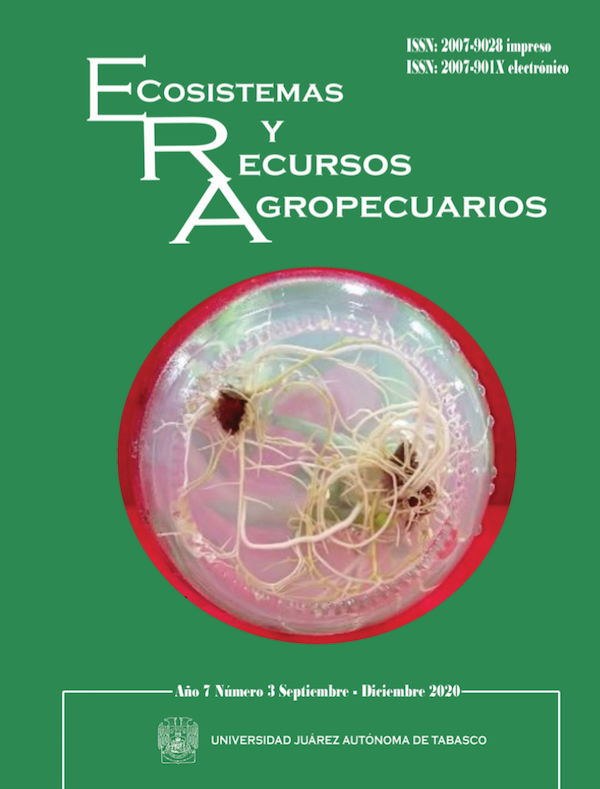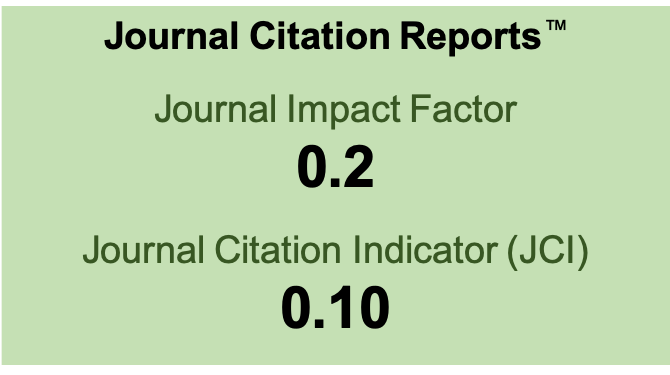Molecular analysis of a polypeptide of the RmS-17 protein for the development of a vaccine against Rhipicephalus microplus ticks in Mexico
DOI:
https://doi.org/10.19136/era.a7n3.2537Keywords:
Garrapatas, inmunógeno, México, R. microplus, RmS17Abstract
The aim of this work was to analyze a RmS-17 polypeptide from Rhipicephalus microplus strains and isolates from different states
of Mexico. in silico analysis of the amino acid sequence was performed
in order to select a region of 145 amino acids. Subsequently, a pair of
specific oligonucleotides was designed to amplify the fragment of interest in
each strain and isolate, obtaining a 435 bp amplicon. The products were
cloned into the pCR®4-TOPO®
vector and the plasmids transformed into the competent E. coli TOPO10®
cells. Positive clones were selected for
sequencing purposes. The results showed an identity percentage of 99.08% for the reference strain “Media Joya” with respect to the previously reported strain in Brazil (KC990116.1). The strains “Vargas”, “Hybrid”, “Huastecas” and the isolates from Campeche, Chiapas, Hidalgo, Morelos and Guerrero an identity and similarity percentage of 100% was observed. These results demonstrate a high degree of conservation in the sequence of the RmS-17
polypeptide and suggests that it is appropriate to carry out the development
of an immunogen that will be useful to control R. microplus infestations in
several geographical areas of Mexico.
Downloads
References
Almazán C, Lagunes R, Villar M, Canales M, Rosario-Cruz R, Jongejan F, et al. (2010) Identification and characterization of Rhipicephalus (Boophilus) microplus candidate protective antigens for the control of cattle tick infestations. Parasitology Research 106: 471–479.
Canales M, Almazán C, Naranjo V, Jongejan F, de la Fuente J (2009) Vaccination with recombinant Boophilus annulatus Bm86 ortholog protein, Ba86, protects cattle against B. annulatus and B. microplus infestations. BMC Biotechnology 9:29.
Crompton D, Kayala A, Traore B, Kayentao K, Ongoiba A, Weiss GE, et al. (2010) A prospective analysis of the Ab response to Plasmodium falciparum before and after a malaria season by protein microarray. Proceedings of the National Academy of Sciences of the United States of America 107: 6958-6963.
Dai J, Wang P, Adusumilli S, Booth CJ, Narasimhan S, Anguita J, et al. (2009) Antibodies against a tick protein, Salp15, protect mice from the Lyme disease agent. Cell Host & Microbe 6: 482–492.
de la Fuente J, Kocan KM (2003) Advances in the identification and characterization of protective antigens for recombinant vaccines against tick infestations. Vaccine 4: 583-593.
de la Fuente J, Kocan KM (2006) Strategies for development of vaccines for control of ixodid tick species. Parasite Immunology 28: 275–283.
de la Fuente J, Moreno-Cid JA, Canales M, Villar M, de la Lastra JM, Kocan KM, et al. (2011) Targeting arthropod subolesin/akirin for the development of a universal vaccine for control of vector infestations and pathogen transmission. Veterinary Parasitology 181: 17-22.
Eisemann CH, Pearson RD, Donaldson RA, Cadogan LC, Vuocolo T (1993) Uptake and fate of specific antibody in feeding larvae of the sheep blowfly, Lucilia cuprina. Medicine Veterinary Entomology 7: 177–185.
García-García JC, Gonzalez IL, Gonzalez DM, Valdés M, Méndez L, Lamberti J, et al. (1999) Sequence variations in the Boophilus microplus Bm86 locus implications for immunoprotection in cattle vaccinated with this antigen. Experimental Applied Acarology 23: 883–895.
George JE, Pound JM, Davey RB (2004) Chemical control of ticks on cattle and the resistance of these parasites to acaricides, Parasitology 129: S353–S366.
Gettins P (2002) Serpin Structure, Mechanism, and Function. Chemical Reviews 102: 4751-4803.
Hütter J, Rödig J, Höper D, Seeberger P, Reichl U, Rapp E, et al. (2013) Toward animal cell culture–based influenza vaccine design: viral hemagglutinin N-glycosylation markedly impacts immunogenicity. The Journal of Inmunology 190: 220-230.
Imamura S, da Silva Vaz Junior T, Sugino M, Ohashi K, Onuma K (2005) A serine protease inhibitor (serpin) from Haemaphysalis longicornis as an anti-tick vaccine. Vaccine 23: 301–1311.
Imamura S, Namangala B, Tajima T, Tembob ME, Yasuda J, Ohashi K, et al. (2006) Two serine protease inhibitors (serpins) that induce a bovine protective immune response against Rhipicephalus appendiculatus ticks. Vaccine 24: 2230–2237.
Kumar S, Stecher G, Tamura K (2016) MEGA7: Molecular Evolutionary Genetics Analysis Version 7.0 for Bigger Datasets. Molecular Biology and Evolution Society 33: 1870-1874.
Lagunes-Quintanilla R, Bautista-Garfias CR (2020) El control inmunológico: Una alternativa contra garrapatas del ganado bovino. Ecosistemas y Recursos Agropecuarios 7: e2263.
Mahajan B, Berzofsky JA, Boykins RA, Majam V, Zheng H, Chattopadhyay R, et al. (2010) Multiple antigen peptide vaccines against Plasmodium falciparum malaria. Infection and Immunity 78: 4613-4624.
Merino-Charrez JO, Gómez-Romero N, Barrera-Molina I, Lagunes-Quintanilla RE (2019) Análisis in silico del gen subolesina como posible vacuna contra garrapatas Rhipicephalus microplus. Ecosistemas y Recursos Agropecuarios 6: 129-136.
Mulenga A, Sugino M, Nakajima M, Sugimoto C, Onuma M (2001) Tick-Encoded Serine Proteinase Inhibitors (Serpins); Potencial target antigens for tick vaccine development. Imnumology. The Journal of Veterinary Medical Sience 63: 1063-1069.
Ostfeld RS, Price A, Hornbostel V, Benjamin M, Keesing F (2006) Controlling Ticks and Tick-borne Zoonoses with Biological and Chemical Agents. BioScience 56: 383 -394.
Rodríguez-Valle M, Xu T, Kurscheid S, Lew-Tabor AE (2015) Rhipicephalus microplus serine protease inhibitor family: annotation, expression and functional characterization assessment. Parasites and Vectors 7:1-9.
Rodríguez-Vivas R, Grisi L, Pérez de León A, Humberto Silva H, Torres-Acosta J, Fragoso, et al. (2017) Potential economic impact assessment for cattle parasites in Mexico. Review. Revista Mexicana de Ciencias Pecuarias 8: 61-74.
Seixas A, Oliveir P, Termignonia C, Logullo C, Itabajaraa M, Da Silva Vaz I (2012) Rhipicephalus (Boophilus) microplus embryo proteins as target for tick vaccine. Veterinary Immunology and Immunopathology 148: 149-156.
Tamura K, Stecher G, Peterson D, Filpiski A, Kumar S (2013) MEGA6: Molecular Evolutionary Genetics Analysis versión 6.0. Molecular Biology and Evolution 30: 2725-2729.
Tirloni L, Seixas A, Mulenga A, Da Silva Vaz Jr. I, Termignoni C (2014) A family of serine protease inhibitors (serpins) in the cattle tick Rhipicephalus (Boophilus) microplus. Experimental Parasitology 137: 25–34.
Tirloni L, Kwon KT, Loner CM, Ali A, Seixas A, Termignoni, C, et al. (2016) The putative role of Rhipicephalus microplus salivary serpins in the tick-host relationship. Insect Molecular Biology 71: 12-28.
Ye S, Cech A, Belmares R, Bergstrom R, Tong T, Corey D, et al. (2001) The structure of a Michaelis serpin–protease complex. Nature Structural Biology 8: 979-983.
Willadsen P (2001) The molecular revolution in the development of vaccines against ectoparasites. Veterinary Parasitology 10: 353–368.
Downloads
Published
Issue
Section
License
Aviso de copyright
Los autores que se envían a esta revista aceptan los siguientes términos:
una. Los autores conservan los derechos de autor y garantizan a la revista el derecho a ser la primera publicación del trabajo con una licencia de atribución de Creative Commons que permite a otros compartir el trabajo con un reconocimiento de la autoría del trabajo y la publicación inicial en esta revista.
B. Los autores pueden establecer acuerdos complementarios separados para la distribución no exclusiva de la versión del trabajo publicado en la revista (por ejemplo, en un repositorio institucional o publicarlo en un libro), con un reconocimiento de su publicación inicial en esta revista.
C. Se permite y se anima a los autores a difundir su trabajo electrónicamente (por ejemplo, en repositorios institucionales o en su propio sitio web) antes y durante el proceso de envío, ya que puede conducir a intercambios productivos, así como a una cita más temprana y más extensa del trabajo publicado. (Consulte El efecto del acceso abierto).



